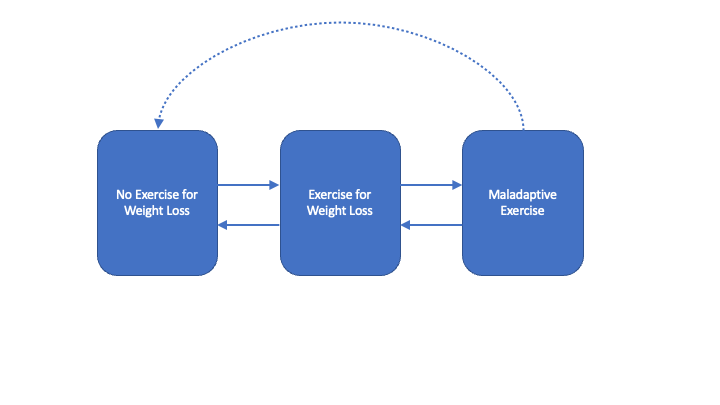Chapter 3 Analytic Plan
Analyses will be gender stratified. The primary predictor variable of interest is time, with the purpose of investigating persistence and changes in exercise behavior over adolescent and young adult development. Secondary predictors include: BMI-Z score at age 13 and Eating Disorder Cognitions at Age 14. Parent SES will be entered as a covariate as it is possible, though not hypothesized, that exercise patterns may vary based on socioeconomic status.
3.1 Multi-State Transition Analyses
The first step in analyses will evaluate overall changes in the presence of exercise for weight loss and maladaptive exercise over time in the sample. Visualization will be completed with transition plots (Cernat 2021) for those completing all four assessment points. For those completing at least two assessment points, transition analysis will include multi-state Markov models for panel data (Jackson 2018), the implementation of which on the current data will describe how individuals move between the ‘No Exercise for Weight Loss’, ‘Exercise for Weight Loss’, and ‘Maladaptive Exercise’ groups over time, with transition intensities representing the instantaneous risk of moving between these three groups. An initial transition matrix will be specified in which instantaneous transitions between adjacent states are permitted, as well as transitions between the Maladaptive Exercise-No Exercise for Weight Loss state (direct transition to exercise abstinence). If initial models do not converge, direct transitions from Maladaptive Ex to No-Exercise for Weight Loss will also be constrained to 0, such that a sojurn through the Exercise for Weight Loss state is required (See 3.1) Transition analyses will be completed separately for boys and girls, and the fitted transition probability matrix, \(P(t)\) will be reported over an interval of 1-year, which will describe the liklihood of transition between exercise groups in a given year during the study time frame. Exploratory analysis of transition states will examine whether baseline covariates (Parent SES, BMI-Z at age 13 years, eating disorder cognitions at age 14 years) impact transition intensities amongst the three exercise groups.

Figure 3.1: Transitions between Exercise Groups
3.2 Missing Data
Prior to mixed-effects modeling, missing data was imputed using the mice and miceadds packages (van Buuren and Groothuis-Oudshoorn 2021; Robitzsch, Grund, and Henke 2022). Imputed variables and imputation approach for each variable is noted in Supplemental Table 8.7. Time-invariant variables were imputed at level-2 only using a Predictive Mean Matching (PMM) approach, and outcome variables were imputed using 2-level approaches, which consider time. Datasets for girls and boys are imputed separately, with 20 imputed datasets. In addition to covariate and predictor variables, parent education was also included in the imputation model specifically to improve imputation of highest parent occupation (measure of SES).
3.3 Mixed Effects Modeling
Mixed Effects Models for ordinal and binary data (Christensen 2015, 2019; Landerman, Mustillo, and Land 2011) examine whether levels of exercise for weight loss and maladaptive exercise change across age. Parameter pooling was utilized to combine models fit to the imputed datasets.
Nested models allow for a random intercept for each individual, then a fixed effect of Time (assessment point - with baseline set to 14 years), followed by fixed effects for all baseline predictors and covariates, and, finally, all Predictor x Time interactions. Models were compared via the multivariate Wald test, using the D1 statistic (van Buuren and Groothuis-Oudshoorn 2011). Parameters for each model are presented in Supplement (Chapter 6 ).